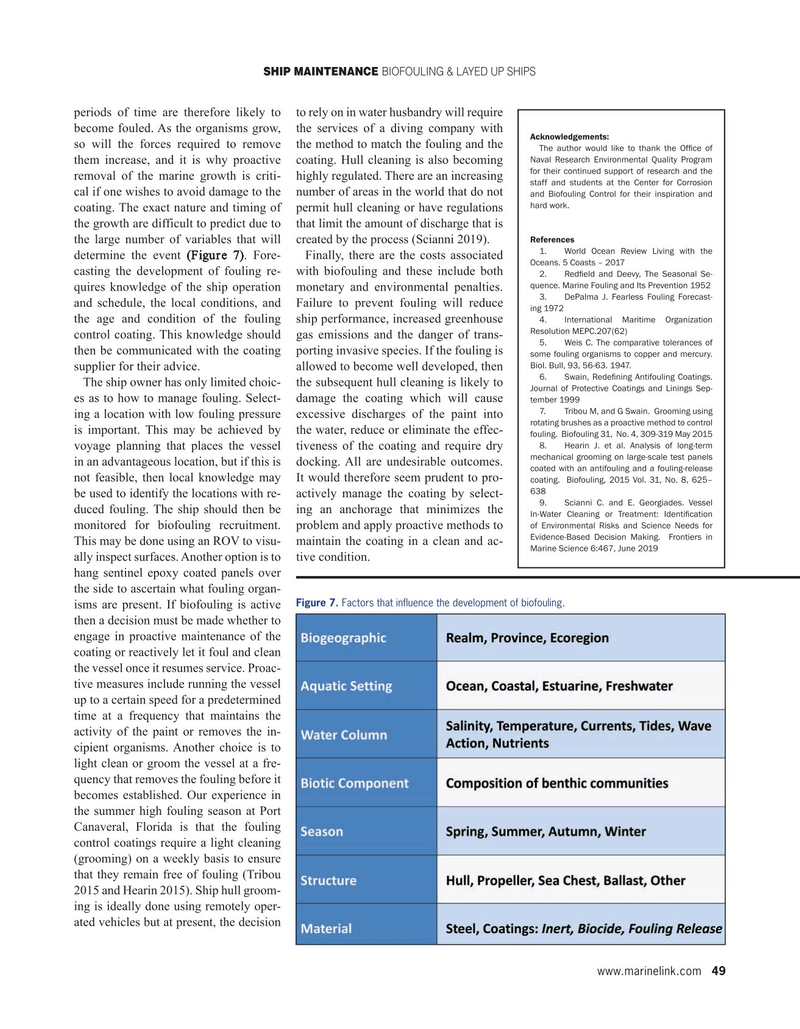
Page 49: of Maritime Reporter Magazine (May 2020)
Fleet Management
Read this page in Pdf, Flash or Html5 edition of May 2020 Maritime Reporter Magazine
SHIp MAINTENANCE Biofouling & layed up ships periods of time are therefore likely to to rely on in water husbandry will require become fouled. As the organisms grow, the services of a diving company with
Acknowledgements: so will the forces required to remove the method to match the fouling and the
The author would like to thank the Offce of
Naval Research Environmental Quality Program them increase, and it is why proactive coating. Hull cleaning is also becoming for their continued support of research and the removal of the marine growth is criti- highly regulated. There are an increasing staff and students at the Center for Corrosion cal if one wishes to avoid damage to the number of areas in the world that do not and Biofouling Control for their inspiration and hard work.
coating. The exact nature and timing of permit hull cleaning or have regulations the growth are difficult to predict due to that limit the amount of discharge that is
References the large number of variables that will created by the process (Scianni 2019). 1. World Ocean Review Living with the determine the event (Figure 7). Fore- Finally, there are the costs associated
Oceans. 5 Coasts – 2017 casting the development of fouling re- with biofouling and these include both 2. Redfeld and Deevy, The Seasonal Se- quence. Marine Fouling and Its Prevention 1952 quires knowledge of the ship operation monetary and environmental penalties. 3. DePalma J. Fearless Fouling Forecast- and schedule, the local conditions, and Failure to prevent fouling will reduce ing 1972 4. International Maritime Organization the age and condition of the fouling ship performance, increased greenhouse
Resolution MEPC.207(62) control coating. This knowledge should gas emissions and the danger of trans- 5. Weis C. The comparative tolerances of then be communicated with the coating porting invasive species. If the fouling is some fouling organisms to copper and mercury.
BioI. Bull, 93, 56-63. 1947.
supplier for their advice. allowed to become well developed, then 6. Swain, Redefning Antifouling Coatings.
The ship owner has only limited choic- the subsequent hull cleaning is likely to
Journal of Protective Coatings and Linings Sep- es as to how to manage fouling. Select- damage the coating which will cause tember 1999 7. Tribou M, and G Swain. Grooming using ing a location with low fouling pressure excessive discharges of the paint into rotating brushes as a proactive method to control is important. This may be achieved by the water, reduce or eliminate the effec- fouling. Biofouling 31, No. 4, 309-319 May 2015 8. Hearin J. et al. Analysis of long-term voyage planning that places the vessel tiveness of the coating and require dry mechanical grooming on large-scale test panels in an advantageous location, but if this is docking. All are undesirable outcomes. coated with an antifouling and a fouling-release not feasible, then local knowledge may It would therefore seem prudent to pro- coating. Biofouling, 2015 Vol. 31, No. 8, 625– 638 be used to identify the locations with re- actively manage the coating by select- 9. Scianni C. and E. Georgiades. Vessel duced fouling. The ship should then be ing an anchorage that minimizes the
In-Water Cleaning or Treatment: Identifcation of Environmental Risks and Science Needs for monitored for biofouling recruitment. problem and apply proactive methods to
Evidence-Based Decision Making. Frontiers in
This may be done using an ROV to visu- maintain the coating in a clean and ac-
Marine Science 6:467, June 2019 ally inspect surfaces. Another option is to tive condition.
hang sentinel epoxy coated panels over the side to ascertain what fouling organ-
Figure 7. Factors that influence the development of biofouling.
isms are present. If biofouling is active then a decision must be made whether to engage in proactive maintenance of the coating or reactively let it foul and clean the vessel once it resumes service. Proac- tive measures include running the vessel up to a certain speed for a predetermined time at a frequency that maintains the activity of the paint or removes the in- cipient organisms. Another choice is to light clean or groom the vessel at a fre- quency that removes the fouling before it becomes established. Our experience in the summer high fouling season at Port
Canaveral, Florida is that the fouling control coatings require a light cleaning (grooming) on a weekly basis to ensure that they remain free of fouling (Tribou 2015 and Hearin 2015). Ship hull groom- ing is ideally done using remotely oper- ated vehicles but at present, the decision www.marinelink.com 49

 48
48

 50
50
